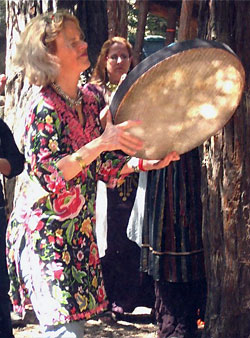CARPET CONCERT
The name 'Carpet Concert' could have come only to the mind of someone who did not grow up in Eastern culture, since for thousands of years the implicit context for music and life in general has been distinguished by sitting on a carpeted floor. Without another frame of reference, the elements of our native environment are 'just the way things are'. Being creatures of habit, we cannot see the forest from the trees. As visitors in a foreign culture, we recognize some distinctions which are invisible for the locals, while other elements pass us by completely.
A 'Carpet Concert' could be defined simply as a musical event where people leave their shoes at the door and sit on the carpeted floor. Consistent with a lifestyle distinction functioning since the 'dawn of civilization' more than 5,000 years ago, a clear line is drawn between the external world, and the interior, private world.
Returning home after a busy day outside, shoes carry dust and the energy of worldly concerns. By removing shoes before entering the private space, we not only maintain the cleanliness of the household, but also change gears internally. The gesture sends a signal to the human spirit that we are shifting to an attitude of vulnerability and receptivity, enabling deep renewal from the cares of the outer world within the sanctified inner environment.
Regardless of the weather outside, in Eastern cultures people remove their shoes at the door before entering the living space. This gesture is such an integral part of their culture that its deeper significance is most often overshadowed by habit; it would simply be unthinkable to cross the threshold before removing one's shoes.
The most practical reasons for the no-shoes policy are cleanliness, respect, and care for the floor, since in many parts of the world today the floor is where people sit and sleep. While floor coverings range from the simplest to the luxurious, for untold ages the most essential and treasured household furnishings have been the carpets, woven by hand primarily by women. Carpets are so highly prized that a woman's rank in traditional society is associated with her skill as a carpet weaver.
In simpler dwellings most activities are conducted within the same space, unlike our modern households whose rooms are designated and furnished for specific uses. While tables, chairs and other seating elements have become fashionable today in urban centers throughout the Middle East, Central Asia and the Balkans, even the previous urban generation slept and sat - by choice - primarily on the carpeted floor in all phases of day-to-day living. In rural areas this tradition is still widely maintained, not only by nomadic tribes but also settled populations.
During my travels over the years throughout rural Turkey and Iran, irrespective of the means of the household, most of the homes I have visited are furnished solely with carpets covering the entire floor and large pillows leaning against the walls. At mealtimes a large cloth is spread on the carpeted floor, and families come together to share their meals picnic style. At night, the same area becomes a bedroom, with mattresses or simple blankets spread out. Families and friends gather for celebrations including poetry and music, colleagues meet for business arrangements, food is prepared, children play; all manner of activities take place in the same multipurpose space while all are sitting on the carpeted floor.
For untold generations throughout the Middle East, the home environment has been sustained by close contact with the patterns, textures, colours, tales and mysteries woven into the carpets. Sitting directly on a carpet brings information to the eyes and tactile sensation to the hands and feet, which are missed while feet are trapped in shoes, perched on a chair over that same carpet. While the body discovers new ways to find comfort, the line of sight while sitting on the floor results in a world view which is starkly different than the perspective from a chair.

